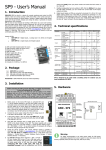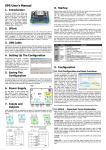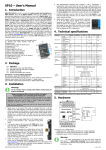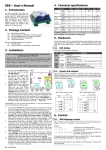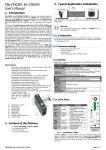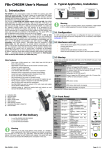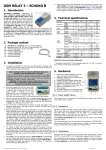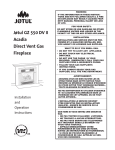Download SP9 - User's Manual
Transcript
SP9 - User’s Manual configuring SP9 with a USB cable, SP9 must be connected to power! Load the configuration from SP9 by clicking the [Load]. Enter your phone number and rewrite the Paul's name on the "User List". 7. Modified configuration has to be written to SP9. Click the [Write]. If you leave the USB cable connected, you can monitor the current state of SP9 inputs, outputs and status. 8. Digital inputs (signals in SP9) are connected to terminals X1 to X9 (or X11) and digital outputs (signals out of the SP9) are connected to terminals Y1 to Y8. Schematics of these signals are listed in the "Hardware" section. In the event of any change on any input SP9 can send to your mobile phone SMS message in the form as "Input1 is closed" (the text depends on SP9 configuration). 1. Introduction GSM-SP9 (SP9 for short) is a device for remote monitoring and control via GSM network. There are three variants of SP9 which differ in usage of input terminals A1,A1+ (see variants of SP9). The number of digital outputs (eight inputs) is the same for all variants. Outputs can change its status or generate pulse depending on SMS command. SP9 can react on input changes by sending an SMS and/or by a voice call. Functions, input and output names, phone numbers, passwords, etc. are fully user configurable from personal computer either locally via USB cable or remotely via GSM data call (CSD) using modem and program SP Init. This configuration program SP Init can be downloaded (free of charge) from the website www.seapraha.cz (English pages Support GSM-SP9). The SP9 box has an integrated DIN rail mount, so you can comfortably place SP9 in the cabinet. Variants of SP9: GSM-SP9-A: 8 digital outputs, 9 digital inputs, 1 analog input 0 to 20mA GSM-SP9-D: 8 digital outputs, 11 digital inputs GSM-SP9-T: 8 digital outputs, 9 digital inputs, 1 analog input (temperature range -50°C to +150°C) 4. Technical specifications Parameter Dimensions*) Supply Each variant is equipped with internal Li-Ion backup battery 10 (1) SIM card holder (located under the cover) (2) USB connector (under the square cover) (3) Outputs (Y): 8 outputs (2 x 4) (4) DIN rail holder (5) Power supply (8 to 30 VDC) (6) LED outputs indication (7) LED SP9 status indication (8) LED inputs indication (9) Analog input (0 to 20 mA) (10) GSM antenna connector (11) Inputs (X): 9 (SP9-A, SP9-T) / 11 (SP9-D) 9 11 Digital inputs DC any polarity 8 7 1 6 2 5 Digital outputs DC, AC 3 4 SP9-A current analog input A1 2. Package 1 1 1 1 pc pc pc pc GSM-SP9 (see variants) GSM antenna (order code GSM-ANT05S) USB cable A-B (order code HW-11.02.8818) printed documentation (this manual) *) Accessories - has to be ordered separately! GSM-SP-BOX-M *) Temperature sensor GSM-C-T2 *) for GSM-SP9-T (range -20 °C to +50 °C) 3. Installation Before inserting the SIM card into the SP9, it is highly recommended to turn off setting of the “PIN code”! Insert the active SIM card (= at least one call was made) to any mobile telephone and turn off the requirement of setting the PIN. On most mobile telephones, this option can be found in menu “Setting the telephone protection” or “Setup -> Security -> PIN control”. Note: The PIN is possible to Symbol w h Width Height (w/o GSM antenna) Depth (between DIN rail and cover) Voltage DC Current Average power consumption SP9-T temperature analog input A1 Conditions MIN. TYP 60 90 d MAX 80 (53 slim) VCC ICC PCC mm 8 30 0,5 VCC = 12V 2,5 Number - Voltage log. H Voltage log. L Current Number Voltage DC Voltage AC Current DC Current AC Number Measured value Measured current Input resistance Resolution Number Range |VIN| |VIN| IIN VOUTDC VOUTAC IOUTDC IOUTAC - 9 (SP9-A,-T) 8 VIN = 12V 12 <4 5 8 11 (SP9-D) 30 4 50 35 100 70 1 Current with user selectable conversion 0 20 RIN Current input Unit mm mm VDC A W V V mA VDC VAC mA mA mA 100 - 12 1 -50 +150 bits °C Recommended temperature sensor: GSM-C-T2 for temperatures -20 to +55°C (GSM-C-T2 sensor accuracy is 1°C in the range 0°C to +30°C ) GSM module Band Temperature Humidity Operational Operational 800/1800 MHz (800/900/1800/1900 MHz on special order) -20 +45 90 tA hR °C % SP9 is designed to be used inside a building only! For outdoor use you need accessories SP9 BOX! *) you can choose variant „slim“ with dimensions (w, h, d) 60 x 90 x 53 mm (order code GSM-SP9-AS, GSM-SP9-DS or GSM-SP9-TS) 5. Hardware GSM antenna activate later when the user became familiar with the configuration procedure of SP9. Inputs 1. 2. Before power on the device SP9 insert an activated SIM card (= call the helpline operator) to the SIM card reader (under the removable cover) and connect GSM antenna. SIM card is inserted into the reader by cut corner down and contacts the center of SP9. Proper insertion can be identified by a mechanical click. SIM card is removed by pressing gently on it (until you hear a click) and release. Now the SIM card can be freely pulled out. Connect the power supply voltage from the DC voltage source 8 to 30 VDC to the terminals + and - power on. 3. If the power supply is OK, the green LED PWR lights. At the same time after about 20 seconds will briefly flash red LED GSM in the interval 1 for 3 sec. 4. Send SMS text messages from a mobile phone in form 1234 STATE to the phone number of the SP9. The device responds with a status message in the form "Test SP9: Window = Closed elevator Heating system = OK = ON SIGNAL = 53%.". To use other functions it’s necessary to configure the device using the program SP Init, see below. 5. 6. Install the SP Init program. The current software version is possible to download (free of charge) at www.seapraha.cz site with GSM-SP9 product. Note: No USB driver is needed because SP9 is a HID device type (see Windows Control Panel System Hardware Device Manager Human Interface Devices – if necessary). Run SP Init (Windows Start: Programs SEA SP Init SP Init). Connect SP9 to your PC via a USB cable which is included in the package. USB connector (B) is located under the small square cover on SP9 (see the picture). When GSM-SP9_Users_Manual_EN_v1-14.docx / 2013-04-26 X4 X6 X8 A1COM X2 X3 X5 X7 X9 A1+ X1 1 3 5 7 SMS PROCESSOR GSM - SP9 7 2 4 6 8 SP9 under the top cover Input status LED indication Connector tor expansion board or unit IN(X) PWR SP9 status GSM LED indication ERR Button SIM card reader 8 OUT(Y) USB www.SEApraha.cz 1 2 3 4 5 6 Output status LED indication Y4 Y5 Y7 Y8 C1-C4 Y2 8-30V + Y3 C5-C8 Y6 DC Y1 Outputs Notes: The button is intended for future use Terminals A1-, A1+ GSM-SP9-A … analog input 0 to +20 mA (connect terminal A1+ to higher potential!) GSM-SP9-T … temperature sensor KTY81-210 (polarity does not matter) GSM-SP9-D … digital input X10 (A1-), X11 (A1+) Warning It’s highly recommended to use extra power supply for SP9 power, galvanically separated from power supply for input and output external circuitry, especially when I/O have long wires, that may be noisy. page #1 of 6 5.1 Digital inputs (X) Digital inputs (SP9 input signals) are connected to the input terminal where the COM terminal is common for all digital inputs X1 to X9 (or X11). The figure shows an example of the connection of external circuits, and internal wiring of input X1 (same for all digital inputs). The polarity does not matter - COM can be plus or minus. GSM-SP9-D has digital input X10 connected to terminal (A1-) and X11 to A1+. External power supply 8 to 30 V DC + SP9 Internal wiring of input X1 Inputs 3k9 X1 Inputs 1k COM X4 X6 X8 A1COM X2 X3 X5 X7 X9 A1+ X1 Digital outputs (SP9 output signals) are connected to the output terminals where the terminal C1-C4 is common for outputs Y1 to Y4 and the terminal C5-C8 is common for Y5 to Y8. The figure shows an example of the external and internal wiring circuits of output Y1 (the same for all digital outputs). Y2 output switches negative branch power relay coil and vice versa Re2 Y6 output switching power supply positive branch of the relay coil Re6 (voltage relay must correspond to an external source voltage!). The polarity of the terminals C1-C4 and C5-C8 terminals is irrelevant - can be plus or minus. SP9 Y4 Y7 Y8 Y5 C1-C4 Y2 8-30V Y3 C5-C8 Y6 + DC Y1 Internal wiring of output Y1 Y1 Výstupy C1-C4 0,2A Re2 Power supply of SP9 8 to 30 V DC Re6 + + SP9-A and SP9-T versions have 1 analog input, which is connected to the input terminals (A1+, A1-). SP9-A - Analog input is designed to measure the current 0-20 mA. The measured value 0-20 mA can be converted to user units. For example the measured current from 4 to 20 mA can be displayed as the pressure of 0-5 MPa (see the chapter Configuration - program SP Init). SP9-T - Analog input is designed to measure the temperature -50°C …+150°C (using KTY 81-210 temperature sensor) 5.4 Front Panel 2 4 6 8 IN(X) PWR GSM ERR OUT(Y) 1 2 3 4 5 6 LED The front panel of the SP9 includes SP9 status LEDs and inputs and outputs status LEDs. The state is only shown for inputs X1 to X8 and all outputs Y1 to Y8 (LED for Y7 and Y8 are located above the USB connector). Under the removable cover is placed SIM card reader, the button (intended for future use) and a connector for connecting of expansion board (GSM-SP-CB2 or GSM-SP-CB5) or unit (GSM-SP-EXP). SIM card is inserted into the reader (cut corner down) and contacts to center of SP9. Proper insertion can be identified by a mechanical click. SIM card can be removed by pressing gently on it (until a click) and release. Then the SIM card can be pulled out. Dark Light Meaning Blink 1x per 3sec Blink Fast 1:1 PWR green Power OFF Power ON or battery powered GSM blue no signal other GSM error GSM OK: normal operation SIM problem red SP9 OK: normal operation Error Error Error ERR Example: 1234 STATE … SP9 returns an SMS containing status 1234 DOUT1 ON … SP9 output1 will be switched on. Confirmation SMS will be returned 1234 DOUT8 PULSE NOBACK … SP9 pulse on output8 will be generated, no confirmation message will be sent back Names of inputs and outputs are user definable by SPInit program. Command SMS may look like this: 1234 GATE=OPEN; HEATING=ON; LAMP=BLINK 6.2 Status SMS Text Message Whenever command SMS contains valid password, SP9 always returns status SMS. Status SMS contains following information: <Device Name>: <LogInput1>=<LogInput1Status> <LogInput2>=<LogInput2Stat us> ... <LogOutput1>=<LogOutput1Status> <LogOutput2>=<LogOutput1Status> ... <GSM Signal Level> Status SMS message contains information only about selected inputs and outputs. Selection is done in configuration program SPInit by checking the appropriate checkbox. GSM - - Explanation Device Name (user configurable) Digital Input 1 is on Digital Input 2 is off Digital Output 3 is on (closed) GSM Signal level in % 7. Configuration For configuration of SP9 is used special program call SP Init. This program can be downloaded free of charge from the website ......... www.seapraha.cz GSM-SP9. Program SP Init enables: Local configuration of SP9 from PC via USB cable Local monitoring of SP9 from PC via USB cable Remote configuration of SP9 from PC via GSM network (CSD) Remote monitoring of SP9 from PC via GSM network (CSD) After installation (during the first run) of the configuration program SP Init it is necessary to select the device variant (SP9-A, SP9-D, SP9-T).Select expansion unit SP9EXP (if connected) or “No extension”. card 1 to 8 (IN) green input not activated input is activated - during transition time before input status is accepted after input change (before SMS can be sent) 1 to 8 (OUT) green output not activated output is activated - - GSM-SP9_Users_Manual_EN_v1-14.docx / 2013-04-26 SP9 Status SMS Example Device SP9: DIn1=on DIn2=off DOut3=on Signal=58% Note: No USB driver is needed because SP9 is a HID device type. See Windows the Control Panel System Hardware Device Manager Human Interface Devices - if necessary. USB connector for PC connection is hidden under the square cover. COLOR SP9 is controlled via SMS messages of GSM network. Command SMS messages are in form: <PASSWORD> <COMMAND> [<RETURN COMMAND >] + 5.3 Analog Input (SP9-A and SP9-T only) 1 3 5 7 6.1 SMS Message control It’s possible to write more commands into one command SMS. For higher readability separate commands by semicolon “;” inside command use “=”. 1234 OUTPUT0=ON; OUTPUT1=ON; OUTPUT3=PULSE; 5.2 Digital outputs (Y) External power supply 8 to 30 V DC 6. Remote Control After connecting the USB cable to SP9 the proper COM port is selected automatically (SP9 has to be powered!). After pressing the [Connect] SP9 establishes communication with the PC (see the "Connection: Connected"). Now it is possible to read, change and write configuration to SP9 or read it or write to a file on PC. 7.1 SPInit - Tab “General” In the "General" tab you can set up the PIN for the SIM card, station name, event after turning on the device and internal inputs. page #2 of 6 7.1.1 Initialization Enter 4 to 8 digit PIN code of the SIM card which is inserted in the SP9 device. (Leave the PIN field empty if usage of the PIN code on the SIM card is disabled). 7.1.2 Response to STATE The Station Name identifies the SP9 device. This text is placed at the beginning of every sent SMS message. It’s also possible add items Show Battery status and Show GSM strength to status SMS by checking these items. 7.1.3 power supply. The value “L” means SP9 is battery powered. Events and state SMS are configured like for any other digital input. 7.3 SPInit - Tab “Digital Outputs” On this tab, you can set configuration of all digital outputs of SP9 device. (These outputs have only two states: YES – NO). These texts will appear in the status SMS. Special actions Use button Actions on power supply recovery to specify the text of SMS messages or voice calls which the SP9 device sends on startup (see chapter Inputs Events). 7.2 SPInit - Tab “Digital Inputs” 7.3.1 On this tab, you can set configuration of all digital inputs of SP9 device. (These inputs have only two states: YES – NO). These fields contain names of outputs and their possible states, which are listed in the status SMS message. These texts will appear in the status SMS. Note: Inputs DIn10 and DIn11 are not available for the SP9-A and SP9-T. Text in Messages Output Name, State L, State H Example: If you name the Output “Output1”, Status L “Off” and Status H “On”, than you will see the following text in the status SMS: "Output1 = Off". Mention in State SMS If this box is checked, the status of this output will appear in the status SMS. Startup 7.2.1 Text in Messages Input Name, State L, State H These fields contain names of inputs and their possible states, which are listed in the status SMS message. Example: When we assign Input as “Input1”, “State L” as Off and “State H” as On, the part of SMS status message concerning Input1 will look like this “Input1=On”. Mention in State SMS If this box is checked, the status of this input will appear in the status SMS message. Remember after turn off If this box is checked, the digital input state before switching off of the SP9 will be remembered. This is important when SP9 has to send an SMS message (or make voice calls) and the input state changes during a power on of SP9. Details are provided in analog inputs. After power on, the SP9 can set an output to "State L", "State H" or retain the status output that was before power off (option "Remember"). 7.3.2 The text used in the command SMS for generating of a pulse on the output (e.g. "pulse"). Duration (h: m: s) Specifies duration of the output pulse. (Note: the duration timers are nonlinear and it may happen that the program adjusts your choice at the earliest possible time, e.g. 25:0:5 is adjusted to 25:0:0). Negate If this box is checked, the meaning of states L (inactive) and H (active) is opposite. 7.4 SPInit - Tab “Analog Inputs” On this tab is selected configuration for analog input A1 variant SP9-A and SP9-T. 7.4.1 7.2.2 Change Notification Transition L => H, transition H => L When the input level is changed than after delay (which is necessary for the recognition of the input state) the requested action (SMS or voice call) is performed. Impulses Command Text in Messages Analog Input Name These fields contain names of inputs and their possible states, which are listed in the status SMS message. Actions Example: When we assign Input A1 as “Current” and check the “Zone” and “Value”, the part of SMS status message concerning input A1 will look like this “Current=High 20mA” for example. Here is possible to select what SMS messages or calls the device has to send when the status changes (see "Events at the inputs"). Mention in state message Actions (SMS or voice calls) to be done on the transition of input signal. (See the chapter “Inputs Events“). If this box for Zone and/or Value is checked, the Zone and/or Value of this analog input will appear in the status SMS message. Negate If this box is checked, the meaning of states L (inactive) and H (active) is opposite. Filter constant Delay (h: m: s) Specifies how long new input state must be stable before action is executed. (Note: the delay timers are nonlinear and it may happen that the program adjusts your choice at the earliest possible time, e.g. 25:0:5 is adjusted to 25:0:0). 7.2.3 Internal input "PWW" - power SP9 has an internal digital input PWW (internally X12 input e.g. for MACRO), which monitors the supply voltage. The value “H” means the SP9 is powered from external GSM-SP9_Users_Manual_EN_v1-14.docx / 2013-04-26 For each analog input is possible to set by the filter value in range 0.2 sec to 30 sec or without filter. Remember after turn off page #3 of 6 If this box is checked, analog input value and zone state will be remembered before shut down of SP9. After power on of SP9 the actual value and zone is compared with stored value and zone and the SMS message is send or not send depending on the change. (Actions and settings) Here is possible to select what SMS messages or calls the SP9 device will send send when the analog inputs status changes (see "Events at the inputs" for details). 7.5 SPInit - Tab “User List” 7.6.1 Automatically repeated actions Action Group A, Action Group B Allows you to specify the time period after which SP9 executes the specified list of events. This is useful e.g. for automatic reporting that the device is functional and can communicate via GSM network. This feature is called "alive". 7.6.2 On problems with sending SMS Specifies how many attempts to send an SMS are made when any problem appears in GSM network. The range is 1 to 31 attempts. Device SP6 has one central user list. For any action a user is chosen from this central user list. 7.6.3 7.5.1 Specifies how many attempts of voice call are made when any problem appears in GSM network. The limit range is 1 to 31 attempts. Existing users Phone number User phone number which is used for sending SMS messages or voice calls for this user. Attention: Authorization of incoming messages does not depend on the phone number - the phone number is used only for sending SMS (or voice call)! Name User name. This area is not used by SP9 device. It is useful for better orientation in list. Code User code. This code is used for authorization of incoming command messages. Received SMS are executed only if it contains “code” of some user in your user list. Message prefix The text which is added in front of SMS message for this user. It is used for sending messages e.g. at e-mail. This message is usually sent on special phone number (e.g. 4616) and first in message is an e-mail address. Pulse on Call The voice call from user’s phone number results into pulse on the selected output (Dout1 to Dout8). Select item “-“ for no pulse. The pulse duration can be set in the “Digital Outputs” in area Impulses. 7.5.2 Lists Users who get copy of all STATUS responses Choose users, to whom the copy of status massage is sent whenever any status message is about to send. 7.6 SPInit - Tab “Advanced” On this tab are placed special advanced features of the SP9. 7.6.4 On problems with Voice call Expert modem setting Service center (SCA) Leave empty. It is intended for users, who have special Service center. Initialization commands Specifies AT commands, which the device sends into the GSM modem at startup. ATTENTION! Commands in this field may cause malfunction of the device. Enter commands only after consultation with the manufacturer of the device! 7.6.5 Indication of device readiness Indication on Dig. Output Selected output is on when the SP9 is connected to GSM network. This function is typically used when indication of GSM connection is necessary. 7.7 SPInit - Tab “SP-CB” (SP9-T) Tab “SP-CB” (SP9-T) is intended for special purposes only 7.8 SPInit - Tab “Monitoring” Program SPInit enables to watch status of inputs and outputs on PC monitor in tab “Monitoring”. Monitoring can be local via USB cable or remote via GSM data connection (CSD). It’s possible to switch on or off digital outputs by clicking on pushbutton [Change] or [Pulse]. It helps to check function of external circuitry. 7.8.1 Operational status List of actual information concerning the SP9 device and it’s functioning. Automaton state Signal strength GSM operator 7.8.2 Information for service purposes only GSM signal level in % Actual GSM operator’s name Digital inputs, outputs and analog inputs List of actual status of all digital inputs, outputs and analog inputs. Terminal The terminal name Unfiltered Measured values of the inputs or outputs of the device are usually filtered to avoid often change of state. In this box you will find the real value of the input device. This is useful especially when the delay is set to a larger transition time, e.g. 1 hour. Name Name of input or output Value Analog input value Zone Analog input zone (e.g. low, high) Age Input values are not updated immediately. Depending on CPU values may be delayed up to 20 seconds. This field will show when an item has been measured last time. When any output is selected, it’s possible to use the right mouse button to change the status and generate a pulse. This is useful for testing the function of the external circuits connected to SP9. Please be patient after pressing – the change of output may take some time (e.g. 20 seconds when connected via GSM). GSM-SP9_Users_Manual_EN_v1-14.docx / 2013-04-26 page #4 of 6 7.9 SPInit - Important Terms Explanation PIN (Personal Identification Number – usually four digits number). Only persons with knowledge of PIN can operate a SIM card (in case the PIN usage on a SIM card was activated). Usage of the PIN can be deactivated. Insert the SIM card to your mobile phone and follow the instruction in the mobile phone manual. (Usually the PIN usage can be deactivated in Menu -> Security -> PIN). ACCESS CODE = Password for SMS commands, configuration and monitoring of SP9 accepts only SMS with a valid access code. The password is requested also for connection of SP9 (via USB cable or remotely via data connection of GSM network). Factory setting of access code is “1234”. EVENT = level change in case of digital input, zone change in case of analog inputs. SP9 can react on EVENTS by several ACTIONS if it is setup this way. SP9 can send SMS messages on selected phone numbers and/or to make voice calls on selected phone numbers. ACTION = one voice call or one SMS to one user. Any EVENT can contain several ACTIONS. USER LIST = List of all users and their phone numbers which are used for ACTIONS. User names are used only for better clarity. SP9 does not use them in any way. DEVICE OFF = Disconnection of SP9 from any form of power supply (including internal battery). DEVICE ON = Connection of SP9 to any form of power supply. (Processor reset has the same effect). POWER ON/OFF = Connection/disconnection of supply terminals from external power supply. (SP9 supplied from internal battery can send SMS about Power recovery and Power outage). 7.10 Remote Configuration SP9 can be configured remotely via GSM data connection (CSD) in the same way like via USB cable (Note: You need any GSM modem connected to your PC). Just click in menu [Options] and in new window called “Options” set the “Station’s phone” number for data connection to SP9. Click [OK] to close the window. For connection select proper COM port which is used for communication with modem and press the button [Connection]. Confirm the phone number [Yes]. When the GSM connection is established it’s possible to operate the SP9 in the same way like via USB. Note: Press [Disconnect] when your task is finished. 7.11 Events SP9 can be set up to inform about events (= changes) on its digital and analog inputs. SP9 sends information via SMS message or makes a voice call. By the SPInit program is possible to set several actions for each event specifying the phone number – user who will receive an SMS message and who will be called. A various SMS can be sent to and a voice call can be made to more phone numbers from the list. The order of SMS and voice calls depends on a list of actions for each action. Voice call rises the probability the user will not miss received SMS message. 7.11.1 How to create an Event First of all the Event has to be created in the configuration program SP Init. Click by a mouse on the symbol of a key . By pushbutton [+ ADD] select requested action of SP9 (SMS or voice call), write the text of SMS which has to be sent or insert the sequence of DTMF numbers in case of a voice call. Now select a user and add him to a list of users for this event by a click on an arrow [>>]. Please check carefully the number of users for an event. In case the number of users is zero nothing will happen (no SMS will be sent). An event for the analog input can be created in the folder Analog inputs. Click by mouse on the symbol key . In the "Type and conversion" can be set: Input type Note: Analog input A1 is current type 0-20 mA (SP9A) or temperature (SP9-T) and cannot be changed. User units GSM-SP9_Users_Manual_EN_v1-14.docx / 2013-04-26 Here it is possible to select the format of the values (not for internal inputs), which used for displaying and the unit values. Conversion In this table, you can specify your own conversion of input values to be displayed (not for internal inputs) In the tab "Zones and events" can be set the name of the zone and the limit value with hysteresis. Whenever the actual value is inside the zone, the zone name is displayed in the status SMS message. Furthermore is possible to set up the action which will be executed after the input level transition (above or below a certain level) after a specified delay. Setting of actions and macros is the same as for the digital inputs Example: Sample configuration with the analog input values conversion to user units: Analog input is configured as current input 0-20 mA. Pressure sensor gives 4 mA at 0 MPa and 20 mA at 10 MPa (see settings in the picture). A/D Converter Range MAX User Units Zone Event SMS (user defined text) HIGH Zone X Value X 100 kPa Increase Over Critical Level! Decrease on Operational Level. Input Value Status SMS Name PRESSURE HIGH 71kPa PRESSURE MIDDLE 69kPa MIDDLE Increase on Operational Level. Decrease below Operational Level! PRESSURE MIDDLE PRESSURE LOW 31kPa 29kPa LOW MIN 0 kPa 7.11.2 Macros Macros are useful when you need to get values or input and output states in event or status SMS messages. Macro [DINx NAME] [DINx VALUE] [DOUTx NAME] [DOUTx VALUE] [AIN1 NAME] [AIN1 VALUE] [AIN1 STATE] [BAT] [SIGNAL] [STATION] Meaning Digital input name Digital input state Digital output name Digital output state Analog input name Analog input value Analog input zone Battery charge level in % GSM signal level in % Station name Example Input1 On Output1 Off Pressure 20 Low 75% 68% SP9 Use the following numbers instead of letter “x”: 1-11 in Dinx ... as the number of digital input 1-8 at DOutx ... as the number of digital output Example: Event SMS prepared in configuration: Alarm! Details: [DIN1 NAME] = [DIN1 VALUE], [DIN5 NAME] = [DIN5 VALUE], [AIN1 NAME] = [AIN1 VALUE] / [AIN1 STATE], Battery = [BAT] %, Signal = [SIGNAL] An incoming SMS message: Office: Alarm! Details: Door = open, Safe = Ok, Pressure = 0.2Pa/Low, Battery = 75%, Signal = 68% page #5 of 6 8. Troubleshooting Problem Problems during installation of SP9 SP9 is not available on GSM network Problems during operation of SP9 Possible reason 9. Frequently Asked Questions Solution 1. What is necessary to use SP9 successfully? SIM card capable to send and receive SMS messages from standard mobile phone and voice / data call incoming and outgoing as well. Please test all these functions in your mobile phone. It’s important to solve all possible problems before using SIM card in SP9. Contact your mobile operator if necessary. No power supply Check power supply Bad or not activated SIM card Test the SIM card in your mobile phone Low credit on prepaid SIM card Check the credit on prepaid SIM card (contact your operator if necessary) Low level of GSM signal Check the connection of GSM antenna. Check the GSM signal level in the place where is located GSM antenna for SP9 (Use your mobile phone with SIM card from SP9). Signal level has to be at least two bars. Check the credit on prepaid SIM card (contact your operator if necessary) 2. What is a phone number of SCA (SCA = Service Center Address) of my mobile operator? (It’s not possible to send an SMS) Contact your mobile operator for this piece of information. Prepaid SIM card is no longer valid because credit was not paid for long time. Usually for more than a year. Test the SIM card in your mobile phone. 4. Where can I find more (and up to date) information? Search GSM-SP9 product on the website www.seapraha.cz English pages Other reason Test the SIM card in your mobile phone. (Sending, receiving SMS, voice call, data call). Low credit on prepaid SIM card Good quality GSM signal in area of installation of SP9 (at least 2 bars on your mobile phone). If there is a problem with GSM signal quality, try to use another type of external antenna, which can be placed in proper place with better GSM signal and which is connected to SP9 with several meters long coax cable with SMA connector. Sufficient Credit (in case of prepaid SIM card) Cancel all phone calls redirection for a SIM card in SP9 3. I’ve tested SP9 with my own SIM card. Now I cannot find SMS messages formerly stored on my SIM card. SMS from your SIM card were processed by SP9 and then deleted. They were very probably canceled due to syntactical error. 10. SP9 in box Special box for SP9 (order code GSM-SP-BOX-M) with power supply (type GSMPWR1) is produced. Note: This box has to be ordered separately and is designed only for SP9 “slim” variant. Contact your GSM (mobile phone) operator if you have any problem with SIM card in your mobile phone. SP9 has problem with SMS sending Problem with remote configuration via GSM modem SIM card has not active CSD (Circuit Switched Data) data GSM anténa Vstupy X4 X6 X8 A1COM X2 X3 X5 X7 X9 A1+ X1 Make a small video of LED diode blinking on SP9 and send it to service. Check the SCA center setting on SIM card and in SP9 configuration – program SPInit Contact your mobile operator to be sure CSD data tariff is active for both SIM cards (in SP9 and in Modem). Note CSD data is not GPRS! 1 3 5 7 SMS PROCESSOR GSM - SP9 7 + 12V - 2 4 6 8 IN(X) PWR GSM ERR POWER SUPPLY 230V~ / 12V= 8 OUT(Y) USB www.SEApraha.cz 1 2 3 4 5 6 Y4 Y5 Y7 Y8 C1-C4 Y2 8-30V Y3 C5-C8 Y6 + DC Y1 GSM-SP-BOX-M GSM-PWR1 L N Výstupy GSM-SP-BOX-M Warning Don’t locate GSM antenna too close to SP9 analog inputs due to possible noise interference. 230V~ Box parameters: Width: 166 mm Height: 140 mm (without connectors) Depth: 87 mm IP55 11. Warranty General warranty period is 12 months after purchase, when eventual malfunction device will be repaired free of charge in SEA company while shipping to SEA is paid by customer and SEA pays for shipping back to customer. For SW there is 24 months warranty under following conditions: Both CPU and PC software is sold “as is”. The software was created by the best software engineers in SEA and was carefully tested both in SEA and also by SEA customers using GSM applications products made in SEA. In spite of making all possible to get error free software it can happen, that the software in CPU or PC programming SW or their mutual interaction has some error under some specific conditions. If such error is found and the description of the problem including configuration file is sent by E-mail to SEA ltd., the error is removed free of charge and SEA will send new SW by E-mail to customer. SEA ltd. has NO RESPONSIBILITY for any damage, lost, costs and any other problems direct or inducted, caused by such SW error, by eventual device malfunction from any reason or by undelivered SMS from the device. GSM-SP9_Users_Manual_EN_v1-14.docx / 2013-04-26 page #6 of 6






